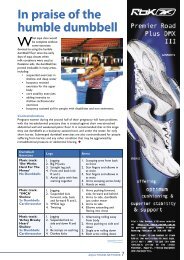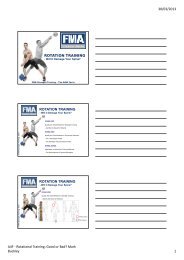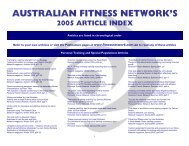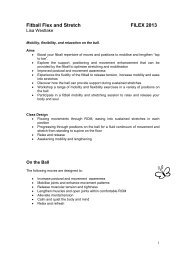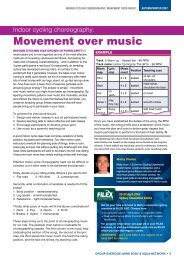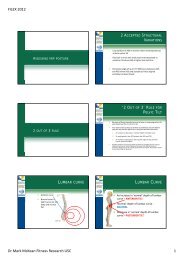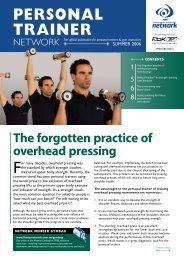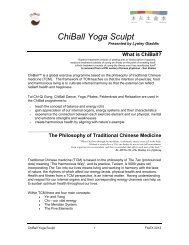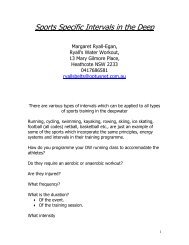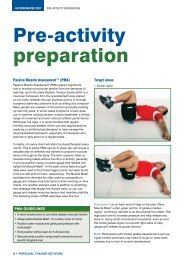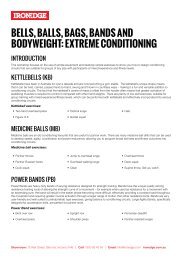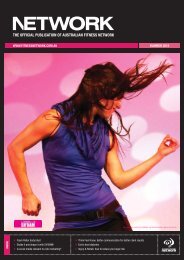CD - Australian Fitness Network
CD - Australian Fitness Network
CD - Australian Fitness Network
You also want an ePaper? Increase the reach of your titles
YUMPU automatically turns print PDFs into web optimized ePapers that Google loves.
deep intrinsic muscles of our spine, for<br />
example, ‘should’ be predominantly<br />
comprised of these non-fatiguable<br />
fi bres. I say ‘should’ because it is often<br />
the case that the necessary conversions<br />
of white fi bres to red fi bres have not<br />
occurred within these muscle groups<br />
for reasons too complex to explain here.<br />
In these cases, people fi nd it almost<br />
impossible to sustain long periods of<br />
upright sitting.<br />
Comprehending these basics of<br />
muscle fi bre recruitment enables us to<br />
understand how human consciousness<br />
infl uences the quality of our movement.<br />
By thinking forcefully about your<br />
fi tness training regime, you will cue<br />
your nervous system to recruit the<br />
fatiguable, white muscle fi bres. How<br />
benefi cial – or detrimental – this may<br />
be is dependent on what you are<br />
attempting to achieve.<br />
A popularised concept in fi tness<br />
training is that of ‘core muscles’. This<br />
refers to the more deeply-situated<br />
intrinsic musculature of our locomotive<br />
system that functions to maintain<br />
the stability of our structure while<br />
we are stationary or in movement.<br />
Complimentary to these intrinsic<br />
muscles is the more superfi ciallysituated<br />
extrinsic musculature that<br />
functions to move our limbs or torso<br />
according to our wish at the time.<br />
The composition of red and white<br />
muscle fi bres within intrinsic and<br />
extrinsic muscles should be weighted<br />
towards the function of each, with the<br />
larger, more powerful muscles in our<br />
body recruiting greater amounts of the<br />
fatiguable white muscle fi bres, and the<br />
core muscles heavily recruiting with<br />
the non-fatiguable, red muscle fi bres<br />
(whether these fi bres are available in<br />
suffi cient numbers for recruitment is<br />
an outcome of the conversion process<br />
mentioned in point 2 earlier, the subject<br />
of another article).<br />
Put your arms in the air<br />
Try this experiment. Get a stop watch or clock with an alarm or a second hand that<br />
you can easily see. Set it for one minute. Now, hold up your arms for 60 seconds<br />
(or 30 seconds if that is too long). You will repeat this exercise two times.<br />
FIRST TIME<br />
Raise both arms, and take the attitude that it is an easy thing to do. Remember<br />
your arms are part of the whole support system of your body, and be aware of<br />
the space around you, with your arms resting in this space. Trust that every part<br />
of you is involved in giving support to the arms, so you can ‘let them be’ while<br />
you take in information from everything that surrounds you.<br />
When your timer goes off, put your arms down, noting how they felt and how<br />
long it felt you had them in the air.<br />
SECOND TIME<br />
After resting, repeat the arm-raising movement, change your attitude and start<br />
thinking about how diffi cult it is to hold your arms up. Focus narrowly into only<br />
your arms. Forget about the room, your body – just think of your arms and the<br />
muscles that must work hard to keep your arms in that position. Keep thinking<br />
‘I have to make an effort to hold my arms up, I have to keep telling them not to<br />
drop down’.<br />
When your timer goes off, put your arms down, noting how they felt and how<br />
long it felt you had them in the air.<br />
The fi rst time was probably much easier than the second time, because your<br />
attitude caused the non-fatiguable red fi bres to come into play. The second time,<br />
your attitude caused the fatiguable white fi bres to come into play. Remember:<br />
every muscle has both kinds of fi bres, but the more our attitude changes,<br />
the more we start developing the red non-fatiguable fi bres to give support to<br />
everything we do.<br />
FITNESS TRAINING THINKING<br />
Bearing in mind the above experiment, consider what happens when I start<br />
demanding that my core muscles give me stability – when my attitude towards<br />
developing my core muscles is that I must put a lot of eff ort into it; a number of<br />
harmful things occur.<br />
Firstly, there is confusion for my nervous system. Support is not a function of<br />
direct motor command, but when we think this way, motor command is the system<br />
we are using, so we are already confusing the design of our system in thinking this<br />
way, building up harmful tendencies which paradoxically lead to the atrophy of our<br />
core muscles.<br />
Secondly, once we stop thinking in this forceful way – which our motor<br />
command is encouraging us to do against the very wish of our own training – the<br />
core muscles stop supporting us in the way we want them to, because we actually<br />
trained them to behave this way. The result is the opposite of our initial training<br />
intention. As long as we keep up the eff ort, there is no problem. However, once<br />
NETWORK WINTER 2010 www.fitnessnetwork.com.au<br />
MIND BODY<br />
33



